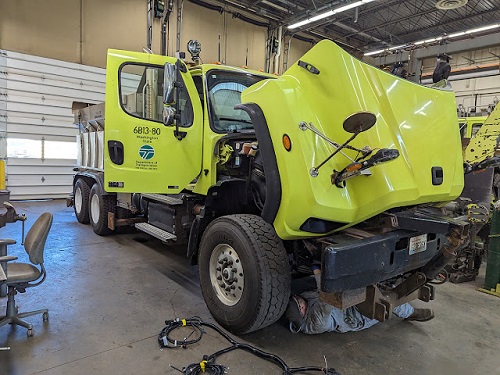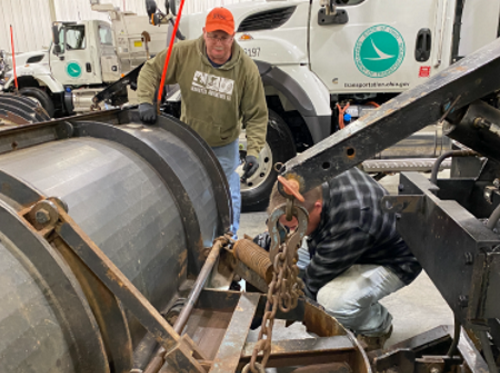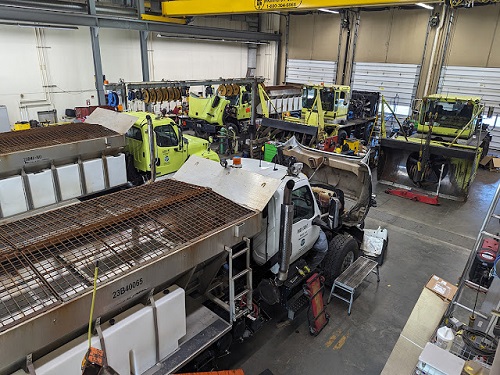In a recent blog post, the Washington State Department of Transportation detailed the upkeep required for the fleet of equipment it uses to keep highways and roads free of snow and ice statewide during the winter.
[Above photo by WSDOT]
The agency noted that while its “named” tow plows – “Plowie McPlow Plow,” “The Big Leplowski,” “Sir Plows-A-Lot,” and “Betty Whiteout” – get a lot of attention, they are just four of 565 snowplows/dump trucks WSDOT maintains statewide; along with 36 motor graders and 29 truck-sized snow-blowers.
Maintaining that equipment requires significant man-hours, WSDOT pointed out. In 2023 alone, the agency spent 846 hours of labor on its snowplows alone; equipment that operated for 18,000 hours during the 2022-2023 winter season.

In preparation for the 2023-2024 winter season, WSDOT said it purchased roughly 1,000 new plow bits – disposable parts that ride on the ground, shave snow and ice from the road and need to be replaced to keep equipment operational – to the cost of $976,380. Plow bits can be replaced monthly if they’re used in moderate snow and as often as every week in heavy snow, while maintenance shops that see little snow may only have to replace them every year, the agency pointed out.
WSDOT said its snowplows cover more than 20,000 lane miles and travel at slower speeds to clear snow properly; operating at right around 25 to 35 miles per hour. The agency added that its snow removal equipment needs constant maintenance and sourcing to find the right part in case something wears out or is damaged in a collision.
Occasionally, WSDOT mechanics must piece various parts together and create “one-of-a-kind” repairs as some of the agency’s snow removal trucks are so old they don’t make parts for them anymore.

WSDOT emphasized that its mechanics service dozens of vehicles every week and, during winter storms, work “both day and night” to turn equipment around as quickly and as safely as possible to get snowplows back on the roads.
“It takes on average up to six hours to transition our dump trucks to operable snowplows during the winter,” explained Bryan Dean, a WSDOT equipment technician supervisor.
“Our mechanics remove the dump body from the truck – which is used to haul dirt and other debris during the spring and summer – then add the salt body container for treating the roads to the back,” he said. “Then we add the actual plow to the front of the dump truck and do a full commercial vehicle inspection before we give them the green light. Our mechanics are checking things like the brakes, windshield wipers, hydraulic hoses and air lines. Additional time may be needed if other repairs are discovered.”
State departments of transportation across the country engage in a variety of activities to prepare for winter operations.

For example, the Ohio Department of Transportation began conducting safety checks on snowplows and equipment statewide, hiring seasonal drivers and mechanics, as well as topping off salt supplies in early October to ensure it is ready to go when the first hints of winter arrive.
The average first day of measurable snow in Ohio ranges from early November in the northern portion of the state to late November for southern Ohio, the agency noted.
“Maintaining Ohio’s highways is a year-round job for Ohio DOT, and it’s never too early for crews to start thinking about winter travel,” said Governor Mike DeWine (R) in a statement. “It takes a great deal of planning and coordination before the snow falls to help ensure that roads stay clear during and after each storm.”
Meanwhile, some state DOTs – such as the New Mexico Department of Transportation and South Carolina Department of Transportation – are using snowplow simulators to help fine-turn the equipment operating skills sets of their highway crews.
Finally, others conduct winter training drills. The Arkansas Department of Transportation’s Winter Weather Strike Team, for one, recently conducted training drills in the central part of the state; drills that included driver training, performing equipment checks and maintenance, road-testing snowplow trucks, and testing communications with the agency’s Emergency Operations Center.
This team works around the clock to clear snow and ice from Interstates and Highways by working in tandem with county and regional maintenance forces to ensure roadways statewide are safe.
When members of the Strike Team are not responding to a winter weather event, they serve as members of striping, signing, milling, and bridge operations maintenance crews, the agency said.
“We do everything we can to be prepared and work efficiently when winter weather hits,” noted Michael Kelly, Arkansas DOT staff maintenance engineer and emergency management liaison officer, in a statement.
 States
States
Georgia DOT Foreman Receives Two Heroism Awards
January 2, 2026 States
States

